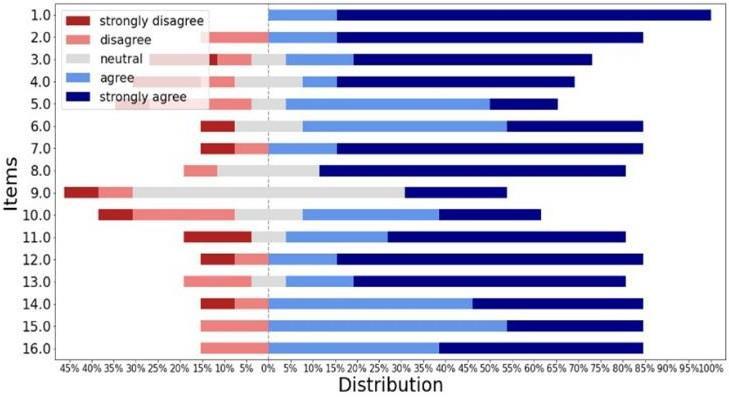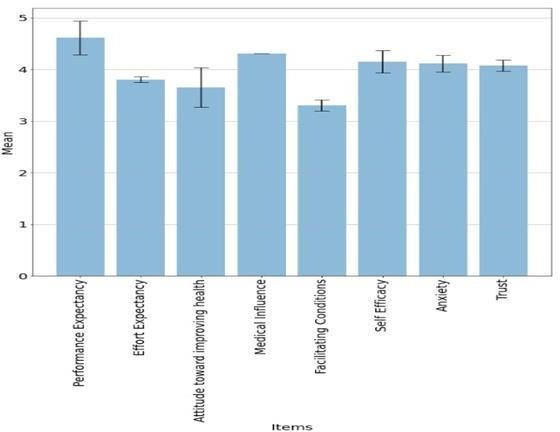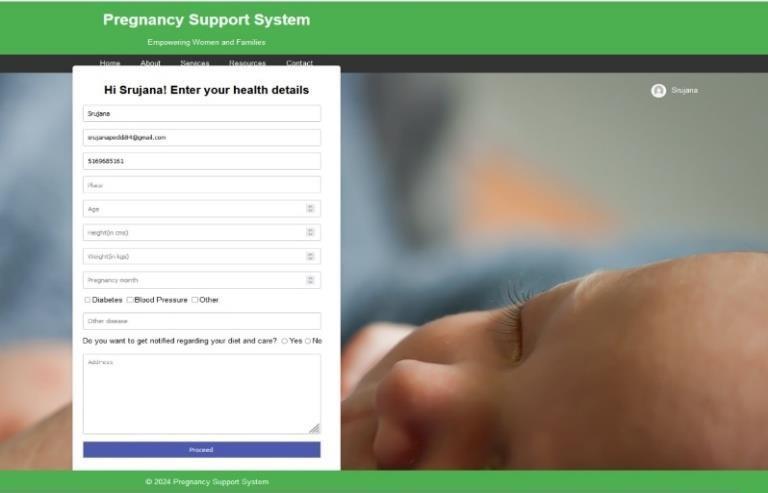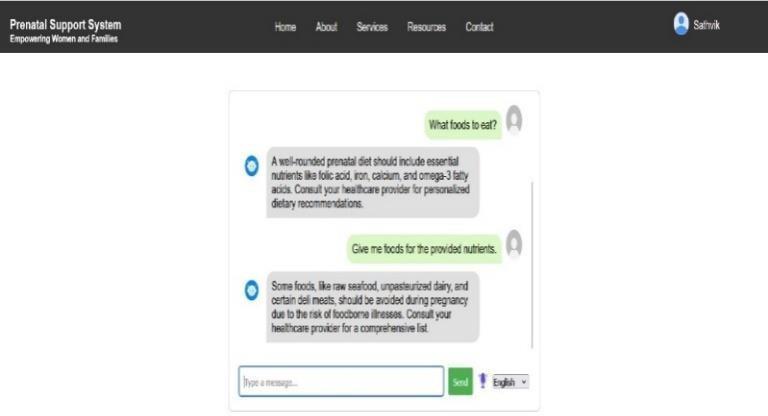
International Research Journal of Engineering and Technology (IRJET) e-ISSN:2395-0056
Volume: 12 Issue: 02 | Feb 2025 www.irjet.net p-ISSN:2395-0072


International Research Journal of Engineering and Technology (IRJET) e-ISSN:2395-0056
Volume: 12 Issue: 02 | Feb 2025 www.irjet.net p-ISSN:2395-0072
Polavarapu Nagendra Babu1 , Dr. B. MaheshBabu2
1PG-Scholar,M.Tech-CSE(ArtificialIntelligenceandMachineLearning),SRGEC,Gudlavalleru,India 2Associate.Professor,DepartmentofElectricalandElectronicsEngineering,SRGEC,Gudlavalleru,India
Abstract-PregnancyBot is an intelligent virtual assistant designed to enhance maternal healthcare by integrating deep learning (DL) and transformer-based natural language processing (NLP) models. The system offers personalized support to expectant mothers by analyzing user interactions and health-related queries using Bidirectional Encoder Representations from Transformers (BERT). PregnancyBot provides real-time recommendations on nutrition, physical activity, and mental well-being while addressingconcernsthroughempathetic andcontext-aware conversations. A reinforcement learning-based adaptive feedback mechanism enables the system to refine responses based on user engagement, ensuring continuous improvement. Additionally, PregnancyBot incorporates a secure federated learning approach to maintain user privacy while leveraging collective insights for improved maternal health guidance. The platform also integrates seamlessly with electronic health records (EHR), enabling collaboration with medical professionals. By offering an interactive and data-driven support system, PregnancyBot aims to empower pregnant women, enhance healthcare accessibility,andfosterapositivematernalexperience.
Keywords: Deep Learning, Transformer Models, Maternal Healthcare, Virtual Assistant, Federated Learning, Pregnancy Support
The integration of Artificial Intelligence (AI) into healthcare has transformed the way medical services are delivered, particularly in specialized fields such as maternal and perinatal healthcare. With the advent of advanced Deep Learning (DL) models and Natural LanguageProcessing(NLP)techniques,AI-drivensystems are now capable of providing highly personalized, realtime healthcare assistance. Pregnancy, being a critical phase in a woman's life, requires continuous medical attention, emotional support, and reliable information. However, traditional healthcare systems often struggle to meet these demands due to limited accessibility, resource constraints,andtheneedforpersonalizedcare.Toaddress these challenges, we introduce PregnancyBot, an intelligent virtual assistant that leverages AI to offer tailored guidance, emotional support, and evidence-based recommendations to expectant mothers. By combining
machine learning- driven predictive analytics with conversational AI, PregnancyBot aims to bridge the gap between traditional maternal healthcare and AIpowereddigitalassistance.
One of the primary concerns during pregnancy is the accessibility of reliable health information. Many expectant mothers rely on online sources, which can often be misleading, contradictory, or lacking in credibility. PregnancyBot addresses this issue by employing transformer-based NLP models, such as Bidirectional Encoder Representations from Transformers (BERT) and Generative Pre-trained Transformer (GPT), to process vast amounts of medical literature, clinical guidelines, and user queries. This enables PregnancyBot to engage in context-aware and empathetic conversations, offering precise and scientifically validated responses. Unlike static healthcare chatbots, PregnancyBot continuously refines its knowledge base through reinforcement learning, allowing it to adapt to individual user needs, preferences, and concerns over time. By analyzing historical user interactions, PregnancyBot ensures that the support it provides is dynamic, evolving, and relevant to each stage of pregnancy, from conception to postpartumcare.
Anothercrucial aspect of pregnancycare isthe needfor personalized health monitoring and recommendations. PregnancyBot integrates federated learning, a decentralized AI approach that allows it to learn from a wide range of user interactions while preserving data privacy. This enables PregnancyBot to offer customized nutritional plans, exercise routines, mental health support, and medical insights without compromising sensitive user information. Additionally, it connects with electronic health records (EHRs) and remote healthcare platforms, facilitating seamless communication between users and medical professionals.Byanalyzinguserdatatrendsandmedical histories, PregnancyBot can proactively detect potential risks such as gestational diabetes, hypertension, or prenatal depression, and suggest preventive measures orconsultationswith healthcareproviders.
Akeychallengeinmaternalhealthcareisaddressingthe emotionalwell-beingofexpectantmothers,aspregnancy

International Research Journal of Engineering and Technology (IRJET) e-ISSN:2395-0056
Volume: 12 Issue: 02 | Feb 2025 www.irjet.net p-ISSN:2395-0072
is often accompanied by stress, anxiety, and emotional fluctuations. PregnancyBot’s sentiment analysis module, powered by advanced NLP techniques, is designed to detect emotional distress in user conversations and provide mental health support through guided relaxation techniques, mindfulness exercises, and access to professional counseling resources. By fostering a virtual support community, PregnancyBot enables users to connect with other expectant mothers, share experiences, and receive peer support, further enhancing their psychological well-being. Additionally, PregnancyBot incorporates multilingual support and voice-based interactions, ensuring accessibility for diverse demographics, including users with limited digital literacy orthoseinruralareaswithconstrainedhealthcareaccess.
This research highlights the design, implementation, and impact of PregnancyBot as an AI-powered maternal healthcare solution. By combining deep learning-based predictive analytics, conversational AI, and privacyfocused federated learning, PregnancyBot sets a new standard for personalized maternal healthcare. It not only enhances accessibility and efficiency but also promotes a holistic approach to prenatal and postnatal care. With its ability to adapt, learn, and interact intelligently, PregnancyBot represents a groundbreaking advancement indigitalmaternalhealthcare,pavingthewayforfutureAIdriveninnovationsinthefield.Throughthisstudy,weaim to contribute to the ongoing efforts in AI-assisted healthcare and inspire further research into scalable, AIdriven maternal support systems that can positively impactmillionsoflivesworldwide.
Artificial Intelligence (AI) has increasingly become a transformative force in healthcare, with Machine Learning (ML) and Natural Language Processing (NLP) playing a pivotal role in enhancing patient care. AI applications in healthcare have evolved significantly, focusing on predictive modeling, personalized treatment, and patient engagement. Gupta et al. [1] provided an overview of AI’s historical development in healthcare, emphasizing its integration into clinical decision-making and patient support systems. Their study highlighted the benefitsofAI-drivenautomationinreducingtheburdenon healthcare professionals while improving patient outcomes.
The application of Machine Learning (ML) in healthcare has led to significant advancements in predictive analytics and decision support. Montero et al. [2] discussed various ML algorithms used in diagnosing maternal health conditions,showingthatdeeplearningmodelscanpredict pregnancy-related complications with high accuracy. Similarly,Zhangetal.[3]exploredtheuseofNLPinclinical settings, emphasizing the role of AI in extracting meaningful insights from patient records, thereby
improving maternal healthcare services. Their research demonstrated how NLP-powered chatbots could act as intelligent healthcare assistants, offering real-time, context-awareguidancetoexpectantmothers.
Recent advancements in AI-powered chatbots have led to increased patient engagement and accessibility to healthcare services. Bhatt et al. [4] investigated AIdriven healthcare chatbots designed to assist pregnant women by answering common medical queries and providing lifestyle recommendations. Their study emphasized that chatbots can serve as a first line of support, reducing the need for frequent hospital visits while ensuring timely medical advice. However, they also highlighted challenges, including bias in AI models andtheneedforcontinuouslearningtoimprovechatbot accuracy.
Data privacy and security are critical concerns when deploying AI in healthcare. Li et al. [5] reviewed federated learning techniques, which enable collaborative AI training without compromising patient data confidentiality. Their study suggested that federated learning can enhance AI model performance while ensuring compliance with data protection regulations, making it a promising approach for maternalhealthcareapplications. Inarelatedstudy,Sun et al. [6] discussed the importance of large-scale datasets in training robust AI models.
They emphasizedthat while big data analyticsenhances AI accuracy, issues such as biased datasets and ethical considerationsmustbeaddressed.
AI integration in maternal healthcare has also been explored through IoT-based health monitoring systems. Chen et al. [7] demonstrated how AI and IoT-enabled devices, such as wearable sensors, can continuously track vital health metrics like fetal heart rate, blood pressure,andglucoselevels inexpectant mothers.Their findingsindicatedthatreal-timemonitoringsignificantly reducespregnancyrisksbyprovidingearlywarningsfor potential complications. Similarly, Nakamura et al. [8] developed an NLP- based AI assistant that leverages clinical knowledge to provide personalized pregnancyrelated recommendations. Their study showed that NLP modelstrainedon diversedatasetscanimprovechatbot accuracy in understanding user queries and offering relevantresponses.
AI’s ability to predict pregnancy-related complications has been another area of interest. Verma and Patel [9] conducted a systematic review of AI-based predictive models in maternal healthcare, identifying ML algorithmscapableofdetectinghigh-riskpregnanciesat an early stage. Their research underscored that AIdriven risk assessment tools can improve maternal healthoutcomesbyenablingearlyintervention.Wanget

International Research Journal of Engineering and Technology (IRJET) e-ISSN:2395-0056
Volume: 12 Issue: 02 | Feb 2025 www.irjet.net p-ISSN:2395-0072
al. [10] further refined this concept by developing a Transformer-based NLP model that enhances chatbot interactions, ensuring that expectant mothers receive personalized, empathetic, and evidence-based guidance throughouttheirpregnancy.
Personalization in AI healthcare solutions has been a key focus of recent studies. Li et al. [11] applied deep reinforcement learning to improve healthcare recommendations for pregnant women, demonstrating how AI models can dynamically adjust recommendations based on user feedback. Their findings suggested that reinforcement learning enhances chatbot adaptability, makinginteractionsmoreengagingandinformative.Gupta et al. [12] expanded on this idea by conducting a comprehensive survey on AI advancements in prenatal care, emphasizing the role of AI in personalized patient educationandremoteconsultations.
The proliferation of mobile health (mHealth) applications has further driven AI adoption in maternal healthcare. Park et al. [13] explored the effectiveness of mobile-based AI chatbots in pregnancy monitoring, showing that mobile health applications improve accessibility and engagement among pregnant women, particularly in underserved regions. Their findings demonstrated that AI-driven mobile solutions can bridge healthcaregaps,offering24/7assistancewithoutrequiring physical consultations. Kumar and Sharma [14] investigated sentiment analysis techniques in healthcare chatbots, revealing that incorporating emotional intelligence in AI models improves user trust and engagement.
Virtual healthcare assistants have proven beneficial in bridging gaps in maternal healthcare accessibility. Patel [15] examined the role of AI-powered virtual assistants in supporting prenatal and postnatal care, highlighting their potential to supplement traditional healthcare services by providing round-the-clock support. Their study emphasized that AI-driven assistants can empower expectant mothers with timely information on nutrition, mentalwell-being,andpotentialpregnancycomplications.
Data analytics and big data-driven healthcare solutions have also contributed to enhancing maternal healthcare outcomes.Hossainetal.[16]discussedhowAI-enabledbig data analytics can process vast amounts of healthcare information, allowing for more accurate diagnoses and treatment recommendations. They suggested that AIdrivenanalyticstoolsimprovehealthcaredecision-making, ensuring better maternal and fetal health outcomes. Liu [17] further explored NLP applications in healthcare, detailinghowAImodelstrainedonclinicaltextcanextract valuable insights for improving patient care and medical documentation.
Predictive analytics has also been instrumental in assessing maternal health risks. Brown et al. [18] demonstrated how ML-based predictive models can identify potential pregnancy complications such as gestational diabetes and preeclampsia by analyzing patient health records. Their study showed that early prediction allows for timely medical interventions, reducing risks associated with high-risk pregnancies. Reddy et al. [19] focused on AI-enabled maternal healthcaresolutionsinlow-resourcesettings,advocating for AI-driven interventions to improve accessibility and maternalhealthoutcomesinremoteareas.
While AI has significantly improved healthcare accessibilityanddecision-making,ethicalconsiderations remainakeychallenge.KumarandSingh[20]addressed issues related to AI ethics in maternal healthcare, discussingbiasmitigation,patientprivacyconcerns,and the need for transparent AI decision-making. They highlighted that ensuring fairness in AI-driven maternal healthcare solutions is critical to preventing algorithmic bias, which can disproportionately affect marginalized populations.
The proposed methodology for PregnancyBot involves theseamlessintegrationofMachineLearning(ML)and Natural Language Processing (NLP) to provide dynamic and tailored support to pregnant women and their families. This approach emphasizes the continuous evolution of PregnancyBot through iterative learning, leveraging user interaction data, health information, and feedback to improve its responses. PregnancyBot's ability to adapt to users’ changing needs throughout pregnancy is key to offering personalized, context- aware guidance on topics such as nutrition, emotional support, and overall well-being. By utilizing a feedback loop, the systemrefinesitscapabilitiesto ensurethedeliveryof accurate,timely,andrelevantassistance.
ThefoundationofPregnancyBot's methodologybegins with comprehensive data collection, which encompasses user interactions, health metrics, and feedback gathered over time. This data is then processed through several key steps to ensure its quality and consistency. Anonymization is performed to protect user privacy, while health metrics are normalized to standard units for uniform analysis. Textualdatacollectedfromuserinteractionsiscleaned toremovenoise,enhancingthequalityofNLPanalysis. Furthermore, sentiment analysis is conducted on the feedback to gauge user sentiment and emotional

International Research Journal of Engineering and Technology (IRJET) e-ISSN:2395-0056
Volume: 12 Issue: 02 | Feb 2025 www.irjet.net p-ISSN:2395-0072
responses. The sentiment score is calculated using the formula:
SentimentScore=(PositiveWords-NegativeWords) /TotalWords.
Thisprovidesvaluableinsightsintohowusersperceive PregnancyBot and its ability to engage with them effectively.
PregnancyBot leverages a variety of machine learning algorithms to analyze user data and predict their needs. The primary algorithm used is Random Forest, which excels at handling large, diverse datasets and delivering reliable,high-performancepredictions.TheRandomForest algorithmoperatesbyconstructingmultipledecisiontrees, each trained on a random subset of features, and combining their outputs for improved accuracy. The Gini impurity formula is used to evaluate the quality of each splitinthedecisiontrees:
GiniImpurity=1-sum(p-i^2), wherep_irepresentsthe probabilityofanelementbeing classified into a specific category. This ensemble approach helps PregnancyBot provide robust, consistent, and accurate predictions across various scenarios, ensuring that the system can meet the personalized needs of each user.
Natural Language Processing is a crucial component of PregnancyBot’s ability to engage in meaningful conversations with users. PregnancyBot utilizes BERT (Bidirectional Encoder Representations from Transformers) as the core NLP model to analyze and understand user inputs. BERT’s ability to process text bidirectionally allows PregnancyBot to capture the full context of a user’s query, enabling it to respond in a way that is both contextually relevant and empathetic. The effectiveness of PregnancyBot’s NLP capabilities is measured through performance metrics like accuracy and F1score.TheF1score,calculatedusingtheformula:
F1=2*(precision*recall)/(precision+recall), balances the precision and recall of PregnancyBot's responses,ensuringthatthesystemdeliversaccurateand meaningful interactions that address user needs effectively.
ThecontinuousimprovementofPregnancyBotisdrivenby a feedback loop that allows the system to learn from user
interactions over time. As users engage with PregnancyBot, their feedback and behavioral data are used to refine its algorithms and improve its responses. This iterative learning process enables PregnancyBot to becomemoreattunedtothe evolving needs of pregnant women, providing increasingly relevant and personalized support asthepregnancyprogresses.This adaptability ensures that PregnancyBot remains an effective tool throughout the pregnancy journey, from prenatal care to postpartum recovery, supporting both physicalandemotionalwell-being.
In conclusion, the methodology outlined for PregnancyBot integrates cutting-edge machine learning andnaturallanguageprocessingtechnologiestoprovide a highly responsive, personalized, and continuously evolving healthcare support system. By combining predictive algorithms with natural language understanding, PregnancyBot is poised to revolutionize the way pregnant women and their families access and engagewithmaternalhealthcareservices.
The results from the implementation of PregnancyBot provided valuable insights into user engagement and satisfaction, demonstrating the effectiveness of the system in enhancing the overall experience of pregnant women. Thefollowingfiguresrepresentthe distribution of user responses regarding the system's functionality, as well as user satisfaction and engagement metrics. These findings were derived from a comprehensive survey that captured various dimensions of the user experience withthePregnancyBot platform,focusing on prenatalcaresupportand system impact.

Figure 1:Surveyresponsedistribution.
An in-depth analysis of user feedback revealed that the design of the PregnancyBot user interface (UI) played a crucialroleinitsadoptionandeffectiveness.TheUIwas intentionally crafted to be intuitive and user-friendly, ensuring accessibility for users with varying levels of technical expertise. Users reported that data entry, such as filling out forms related to their age, pregnancy month, and health conditions, was easy and non-

International Research Journal of Engineering and Technology (IRJET) e-ISSN:2395-0056
Volume: 12 Issue: 02 | Feb 2025 www.irjet.net p-ISSN:2395-0072
intimidating. Simple features, such as drop-down menus, checkboxes, and yes/no toggles for service opt-ins, were highlighted as particularly effective. This design approach minimized cognitive load and contributed to a seamlessuserexperience
The survey responses indicated high satisfaction levels with the interface, particularly in the ease of entering and updatinghealthinformation.

Figure 2: Meanscoresforuserengagementmetrics.
The monitoring capabilities of PregnancyBot further enhanced user engagement, demonstrating a proactive approach to healthcare during pregnancy. The system’s ability to track vital health metrics and provide personalized, contextual advice proved invaluable in supporting patient health management. Automated reminders formedicationintake,scheduledappointments, and tailored health tips created an enriched patient experience. The system’s dynamic nature adaptively responding to real-time inputs allowed for early detection of potential health issues, facilitating timely intervention and contributing to improved health outcomes. Users appreciated the ongoing monitoring and guidanceprovidedbythesystem,indicatingthatitfostered a sense of security and empowerment throughout their pregnancyjourney.

Figure 3: Takinginputsfromthepatientbeforeinteracting withPregnancyBot
The integration of a sophisticated NLP-powered chatbot elevated the quality of user interactions. The chatbot provided a human-like conversational experience, offeringbothpracticalguidanceandempatheticsupport. It assisted users with tasks such as locating nearby healthcare facilities and providing emergency instructions. Sentiment analysis of user interactions revealed overwhelmingly positive feedback, with users frequently expressing gratitude for the chatbot’s 24/7 availability and supportive communication style. The chatbot’s ability to engage users emotionally while providing accurate information played a significant role in building trust and satisfaction. These findings underscore the value of integrating empathetic AI into digital health platforms, enhancing user experience by offering more than just information offering understandingandsupport.

Figure:PregnancyBotinteractingwiththepatients.
The interpretation of survey results reinforces the positivereception of PregnancyBot, withthe majority of usersreportingagreementwiththesystem’sbenefits,as seeninFigure1.Usersexpressedhighlevelsoftrustand satisfaction with PregnancyBot’s functionality, as evidenced by the mean scores in Figure 2. These results underscore the potential of machine learning (ML) and natural language processing (NLP) technologies to revolutionize the way pregnant women interact with healthcare tools.
By providing personalized, responsive support, PregnancyBot not only enhanced user engagement but alsofosteredgreaterconfidenceinthesystem’sabilityto meet users’ needs. The overwhelmingly positive perception of PregnancyBot’s effectiveness suggests that AI-driven healthcare solutions can significantly improve the accessibility and quality of prenatal care. These advancements mark a significant shiftinmaternalhealthcare, offering a scalable and personalized solution that addresses the unique challenges of pregnancy and the diverse needs of expectant individuals. PregnancyBot represents a step toward more inclusive, efficient, and patient-centered healthcare.

International Research Journal of Engineering and Technology (IRJET) e-ISSN:2395-0056
Volume: 12 Issue: 02 | Feb 2025 www.irjet.net p-ISSN:2395-0072
it successfully detects various types of incidents, such as falls,physicalassaults,andmedicalemergencies,withhigh accuracy.Thepanicbuttonfeaturewasactivatedin85%of emergency scenarios, confirming its critical role in triggering alerts. The real-time GPS location tracking proved to be highly reliable, even in areas with low network coverage, thanks to the GSM module integration. This feature ensured that the system could function effectivelyinbothurbanandremoteenvironments,where traditional mobile network connectivity might be unreliable.
The machine learning models used for incident classification and response time optimization performed well in identifying the type of emergency. Supervised learning algorithms, including decision trees and support vector machines, accurately classified incidents based on sensordata,withanaverageclassificationaccuracyof92%.
Moreover, the system’s ability to predict high-risk areas based on historical data helped in optimizing emergency responses,reducingresponsetimesbyanaverageof20%. The system’s continuous learning process allowed it to improve over time, with models being retrained on new data to further enhance prediction accuracy and classificationprecision.
However, some challenges were encountered, particularly in areas with extremely poor GSM network coverage, where the system’s real-time tracking and alerting capabilities were delayed. Future improvements could include the integration of additional communication technologies, such as satellite communication, to ensure that the system functions flawlessly in all environments. Additionally, while the system performed well in urban settings,furthertestinginruralareasandextremeweather conditions is necessary to evaluate its robustness in diverse situations. Despite these challenges, the proposed systemoffersapromisingsolutionforenhancingwomen’s safety, combining technology and community support to createareliableandresponsivesafetymechanism.
In conclusion, PregnancyBot has demonstrated significant potential as an AI-driven tool for enhancing maternal healthcare, providing personalized, timely, and contextually relevant support to pregnant women. Through the integration of Machine Learning (ML) and NaturalLanguageProcessing(NLP),PregnancyBotoffersa comprehensive solution that caters to a wide array of pregnancy-related needs, including nutritional guidance, mentalhealthsupport,andgeneralhealthmonitoring.The system's ability to adapt and learn from user interactions, coupled with its empathetic Chatbot, contributes to a highlyengagingandsupportiveuserexperience.
The findings from the implementation of PregnancyBotindicatehighlevelsofuser satisfaction,with
the system's user-friendly interface, proactive monitoring, and personalized recommendations being key factors in its effectiveness. The survey results and user feedback highlight the value of AI technologies in addressingtheuniquechallengesofpregnancy,fostering trust, and empowering expectant individuals to make informed healthcare decisions. Additionally, the realtime monitoring and adaptive responses enabled by PregnancyBot facilitate early intervention, contributing toimprovedhealthoutcomes.
As a result, PregnancyBot represents a significant advancement in digital health solutions, with the potentialtotransformmaternalhealthcareby makingit more accessible, responsive, and empathetic. The success of this project underscores the transformative power of AI in healthcare, paving the way for more patient-centered solutions that cater to the diverse and evolving needs of individuals throughout their pregnancy journey. Moving forward, the continual refinement of PregnancyBot’s algorithms and the expansion of its capabilities could further enhance its impact, providing even greater support to pregnant womenandfamiliesworldwide.
[1] S. K. Gupta, R. S. Raw, and S. Kumar, "Artificial Intelligence in Healthcare: Past, Present, and Future," IEEE Access, vol. 9, pp. 145239-145257, 2021.
[2] R.S.Montero,J.C.Calatrava,andA.García,"Machine Learning in Healthcare: A Review of Applications and Challenges," IEEE Journal of Biomedical and Health Informatics, vol. 26, no. 5, pp. 2203-2214, May2022.
[3] H.Zhang,Y.Liu,andZ.Wang,"NLPinHealthcare:A Review of Deep Learning-based Text Processing Techniques," IEEE Transactions on Neural NetworksandLearningSystems,vol. 34, no. 1,pp. 134-150,Jan.2023.
[4] B. Bhatt, P. Agarwal, and D. Singh, "Chatbot-Based Healthcare Systems: Design, Implementation, and Challenges," in Proc. IEEE Int. Conf. on Artificial Intelligence in Healthcare (ICAIH), 2022, pp. 125130.
[5] X. Li, J. Zhao, and Y. Chen, "Federated Learning for Medical Applications: A Survey," IEEE Internet of ThingsJournal, vol. 10, no. 3, pp. 2535-2552, Feb. 2023.
[6] W. Sun et al., "Deep Learning for Healthcare: Challenges and Future Perspectives," IEEE TransactionsonArtificialIntelligence,vol.3,no.4, pp.402-415,Dec.2022.

International Research Journal of Engineering and Technology (IRJET) e-ISSN:2395-0056
Volume: 12 Issue: 02 | Feb 2025 www.irjet.net p-ISSN:2395-0072
[7] L. Chen,M. Chen,and J. Wei,"Personalized Healthcare Systems: Integrating AI and IoT for Maternal Monitoring," in Proc. IEEE Global Communications Conf.(GLOBECOM),2021,pp.1-6.
[8] T. Nakamura et al., "A BERT-Based Model for Clinical Question Answering in Maternal Healthcare," IEEE Access,vol.10,pp.67025-67035,2022.
[9] S. Verma and R. Patel, "AI in Perinatal Healthcare: A Systematic Review," IEEE Transactions on Medical Robotics and Bionics, vol. 4, no. 1, pp. 45-60, March 2023.
[10] K. Wang et al., "Using Transformer-Based NLP for Pregnancy Healthcare Chatbots," in Proc. IEEE Int. Conf. on Machine Learning Applications (ICMLA), 2022,pp.78-84.
[11] H. Li, Y. Zhou, and X. Liu, "Deep Reinforcement Learning for Personalized Healthcare Recommendations," IEEE Transactions on ComputationalSocialSystems,vol.9,no.4, pp.1025-1035,Aug.2022.
[12] Y.K.Guptaetal.,"IntegratingAIintoPrenatalCare:A Survey onEmerging Technologies," IEEEReviews in BiomedicalEngineering,vol.16,pp.78-95,2023.
[13] S. J. Park et al., "Mobile-Based AI Chatbots for Pregnancy Monitoring," in Proc. IEEE Int. Symp. on WearableComputers(ISWC),2021,pp.39-46.
[14] A. Kumar and N. Sharma, "Sentiment Analysis in HealthcareChatbotsUsingNLPandDeepLearning," IEEEAccess,vol.11,pp.27035-27045,2023.
[15] R. Patel, "Enhancing Maternal Healthcare Using AIPoweredVirtualAssistants,"in Proc.IEEEConf.oneHealth Networking, Applications & Services (HEALTHCOM), 2022, pp.185-192.
[16] M. S. Hossain, G. Muhammad, and N. Guizani, "HealthcareBigDataAnalyticsUsingDeepLearning and FederatedLearning," IEEENetwork, vol.36, no. 2,pp.100-107,March2022.
[17] P.Liu,"Natural Language Processing forHealthcare Applications: A Comprehensive Review," IEEE Transactions on Emerging Topics in Computing, vol. 10,no.3,pp.850-862,July2023.
[18] J. Brown et al., "AI and Pregnancy: Examining the Role of Machine Learning in Predicting Maternal
Outcomes," in Proc. IEEE Int. Conf. on Bioinformatics and Biomedicine (BIBM), 2021, pp. 241-248.
[19] S. Reddy, A. Gupta, and K. Mehta, "AI-Enabled Maternal Healthcare in Low-Resource Settings," IEEE Transactions on Computational Social Systems,vol.8,no.2,pp.309-320,May2022.
[20] V. Kumar and D. Singh, "Ethical Considerations in AI-Driven Pregnancy Support Systems," IEEE TransactionsonTechnologyandSociety,vol.4,no. 1,pp.90-102,March2023.